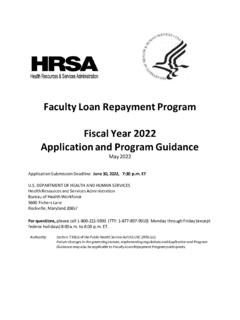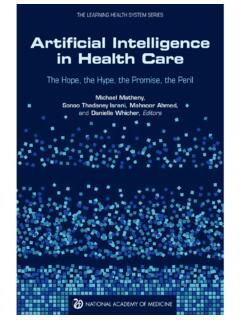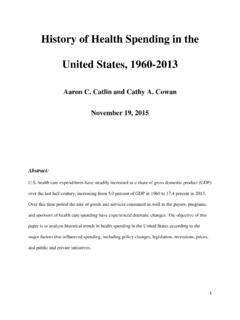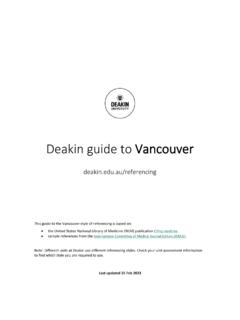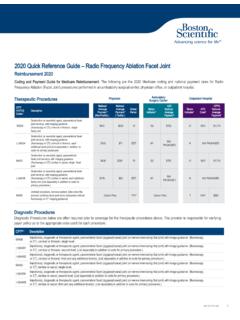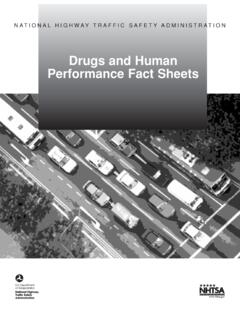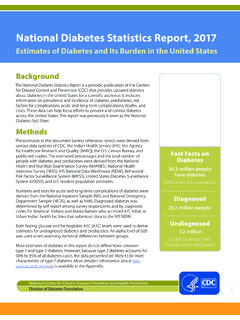Transcription of World Health Organization Model List of Essential Medicines
1 World Health Organization Model List of Essential Medicines 21st List2019 World Health Organization Model List of Essential Medicines 21st List2019 WHO/MVP/EMP/ World Health Organization 2019 Some rights reserved. This work is available under the Creative Commons Attribution-NonCommercial-ShareAlike IGO licence (CC BY-NC-SA IGO; ). Under the terms of this licence, you may copy, redistribute and adapt the work for non-commercial purposes, provided the work is appropriately cited, as indicated below. In any use of this work, there should be no suggestion that WHO endorses any specific Organization , products or services. The use of the WHO logo is not permitted. If you adapt the work, then you must license your work under the same or equivalent Creative Commons licence. If you create a translation of this work, you should add the following disclaimer along with the suggested citation: This translation was not created by the World Health Organization (WHO). WHO is not responsible for the content or accuracy of this translation.
2 The original English edition shall be the binding and authentic edition . Any mediation relating to disputes arising under the licence shall be conducted in accordance with the mediation rules of the World Intellectual Property Organization . Suggested citation. World Health Organization Model List of Essential Medicines , 21st List, 2019. Geneva: World Health Organization ; 2019. Licence: CC BY-NC-SA IGO. Cataloguing-in-Publication (CIP) data. CIP data are available at Sales, rights and licensing. To purchase WHO publications, see To submit requests for commercial use and queries on rights and licensing, see Third-party materials. If you wish to reuse material from this work that is attributed to a third party, such as tables, figures or images, it is your responsibility to determine whether permission is needed for that reuse and to obtain permission from the copyright holder. The risk of claims resulting from infringement of any third-party-owned component in the work rests solely with the user.
3 General disclaimers. The designations employed and the presentation of the material in this publication do not imply the expression of any opinion whatsoever on the part of WHO concerning the legal status of any country, territory, city or area or of its authorities, or concerning the delimitation of its frontiers or boundaries. Dotted and dashed lines on maps represent approximate border lines for which there may not yet be full agreement. The mention of specific companies or of certain manufacturers products does not imply that they are endorsed or recommended by WHO in preference to others of a similar nature that are not mentioned. Errors and omissions excepted, the names of proprietary products are distinguished by initial capital letters. All reasonable precautions have been taken by WHO to verify the information contained in this publication. However, the published material is being distributed without warranty of any kind, either expressed or implied. The responsibility for the interpretation and use of the material lies with the reader.
4 In no event shall WHO be liable for damages arising from its use. This publication contains the collective views of an international group of experts and does not necessarily represent the decisions or the policies of WHO. The recommendations contained in this publication are based on the advice of independent experts, who have considered the best available evidence, a risk benefit analysis and other factors, as appropriate. This publication may include recommendations on the use of medicinal products for an indication, in a dosage form, dose regimen, population or other use parameters that are not included in the approved labelling. Relevant stakeholders should familiarize themselves with applicable national legal and ethical requirements. WHO does not accept any liability for the procurement, distribution and/or administration of any product for any use. 21st edition WHO Model List of Essential Medicines (2019) Explanatory notes The core list presents a list of minimum medicine needs for a basic Health -care system, listing the most efficacious, safe and cost effective Medicines for priority conditions.
5 Priority conditions are selected on the basis of current and estimated future public Health relevance, and potential for safe and cost-effective treatment. Where the [c] symbol is placed next to an individual medicine or strength of medicine on the core list it signifies that there is a specific indication for restricting its use to children. The complementary list presents Essential Medicines for priority diseases, for which specialized diagnostic or monitoring facilities, and/or specialist medical care, and/or specialist training are needed. In case of doubt Medicines may also be listed as complementary on the basis of consistent higher costs or less attractive cost-effectiveness in a variety of settings. Where the [c] symbol is placed next to an individual medicine or strength of medicine on the complementary list it signifies that the medicine (s) require(s) specialist diagnostic or monitoring facilities, and/or specialist medical care, and/or specialist training for their use in children.
6 The square box symbol ( ) is primarily intended to indicate similar clinical performance within a pharmacological class. The listed medicine should be the example of the class for which there is the best evidence for effectiveness and safety. In some cases, this may be the first medicine that is licensed for marketing; in other instances, subsequently licensed compounds may be safer or more effective. Where there is no difference in terms of efficacy and safety data, the listed medicine should be the one that is generally available at the lowest price, based on international drug price information sources. Not all square boxes are applicable to medicine selection for children. Therapeutic equivalence is indicated only on the basis of reviews of efficacy and safety and when consistent with WHO clinical guidelines. national lists should not use a similar symbol and should be specific in their final selection, which would depend on local availability and price. The a symbol indicates that there is an age or weight restriction on use of the medicine ; details for each medicine can be found in Table The presence of an entry on the Essential Medicines List carries no assurance as to pharmaceutical quality.
7 It is the responsibility of the relevant national or regional drug regulatory authority to ensure that each product is of appropriate pharmaceutical quality (including stability) and that, when relevant, different products are interchangeable. For recommendations and advice concerning all aspects of the quality assurance of Medicines see the WHO Medicines website Medicines and dosage forms are listed in alphabetical order within each section and there is no implication of preference for one form over another. Standard treatment guidelines should be consulted for information on appropriate dosage forms. The main terms used for dosage forms in the Essential Medicines List can be found in Table Definitions of many of these terms and pharmaceutical quality requirements applicable to the different categories are published in the current edition of The International Pharmacopoeia WHO Model List of Essential Medicines 21st edition 21st WHO Model List of Essential Medicines (2019) page 1 1.
8 ANAESTHETICS, PREOPERATIVE Medicines AND MEDICAL GASES General anaesthetics and oxygen Inhalational Medicines halothane Inhalation. isoflurane Inhalation. nitrous oxide Inhalation. oxygen Inhalation (medical gas). Injectable Medicines ketamine Injection: 50 mg (as hydrochloride)/ mL in 10- mL vial. propofol* Injection: 10 mg/ mL; 20 mg/ mL. * Thiopental may be used as an alternative depending on local availability and cost. Local anaesthetics bupivacaine Injection: ; (hydrochloride) in vial. Injection for spinal anaesthesia: (hydrochloride) in 4- mL ampoule to be mixed with glucose solution. lidocaine Injection: 1%; 2% (hydrochloride) in vial. Injection for spinal anaesthesia: 5% (hydrochloride) in 2- mL ampoule to be mixed with glucose solution. Topical forms: 2% to 4% (hydrochloride). lidocaine + epinephrine (adrenaline) Dental cartridge: 2% (hydrochloride) + epinephrine 1:80 000. Injection: 1%; 2% (hydrochloride or sulfate) + epinephrine 1:200 000 in vial.
9 Complementary List ephedrine Injection: 30 mg (hydrochloride)/ mL in 1- mL ampoule. (For use in spinal anaesthesia during delivery, to prevent hypotension). Preoperative medication and sedation for short-term procedures atropine Injection: 1 mg (sulfate) in 1- mL ampoule. midazolam Injection: 1 mg/ mL. Oral liquid: 2 mg/ mL [c]. Tablet: mg; 15 mg. morphine Injection: 10 mg (sulfate or hydrochloride) in 1- mL ampoule. WHO Model List of Essential Medicines 21st edition 21st WHO Model List of Essential Medicines (2019) page 2 Medical gases oxygen* Inhalation For use in the management of hypoxaemia. *No more than 30% oxygen should be used to initiate resuscitation of neonates less than or equal to 32 weeks of gestation. 2. Medicines FOR PAIN AND PALLIATIVE CARE Non-opioids and non-steroidal anti-inflammatory Medicines (NSAIMs) acetylsalicylic acid Suppository: 50 mg to 150 mg. Tablet: 100 mg to 500 mg. ibuprofen a Oral liquid: 200 mg/5 mL. Tablet: 200 mg; 400 mg; 600 mg.
10 A Not in children less than 3 months. paracetamol* Oral liquid: 120 mg/5 mL; 125 mg/5 mL. Suppository: 100 mg. Tablet: 100 mg to 500 mg. * Not recommended for anti-inflammatory use due to lack of proven benefit to that effect. Opioid analgesics codeine Tablet: 30 mg (phosphate). fentanyl* Transdermal patch: 12 micrograms/hr; 25 micrograms/hr; 50 micrograms/hr; 75 micrograms/hr; 100 micrograms/hr *for the management of cancer pain morphine* Granules (slow-release; to mix with water): 20 mg 200 mg (morphine sulfate). Injection: 10 mg (morphine hydrochloride or morphine sulfate) in 1- mL ampoule. Oral liquid: 10 mg (morphine hydrochloride or morphine sulfate)/5 mL. Tablet (slow release): 10 mg 200mg (morphine hydrochloride or morphine sulfate). Tablet (immediate release): 10 mg (morphine sulfate). *Alternatives limited to hydromorphone and oxycodone WHO Model List of Essential Medicines 21st edition 21st WHO Model List of Essential Medicines (2019) page 3 Complementary list methadone* Tablet: 5 mg; 10 mg (as hydrochloride) Oral liquid: 5mg/ 5mL; 10mg/ 5mL (as hydrochloride) Concentrate for oral liquid: 5 mg/ mL; 10mg/ mL (as hydrochloride) *For the management of cancer pain.










